Cape Dory 36 - A Survey
by Fraser and Jean Fraser-Harris
Reprinted with permission from Nautical Quarterly No.
18, Summer 1982
Copyright 1982 Nautical Quarterly, Inc.:
All Rights Reserved under Pan American and universal copyright conventions.
Reproduction without permission is prohibited.
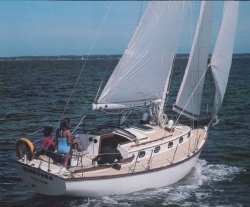
In the same year that I retired from the Navy to turn professional
yachtsman, a much younger man embarked upon a boatbuilding venture.
Andrew Vavolotis, sailor and professional engineer, had learned much
of his boatbuilding skill with the Boston Whaler Company and determined
to try it on his own in 1962. He is still at it, and most successfully.
Construction of the first Cape Dory, a 15-footer, began in his garage
in Brockton, Massachusetts. Soon he moved to a shop in West Bridgewater
where he built fiberglass boats by day and drove the truck that delivered
them at night. Three companies are now under his private ownership
and personal direction-Cape Dory Yachts, Spartan Hardware, and Cape
Dory Charters, Inc. Each one interlocks in this story of his 36' cutter.
The development of Cape Dory Yachts is a Horatio Alger story. Because
it was and still is a private company in the process of growing, decisions
had to be very carefully made; there was no room for failure. Steps
up the ladder from the first 15-footer to this 36' cruising vessel,
launched three years ago, took fifteen of the eighteen elapsed years
since the start of the company. From the 19' Typhoon daysailer to the
projected 45' ocean cruiser now in design, the concept of Andy Vavolotis's
boats has changed little save in size and the requirement of ocean-going
ability. They have all been full-keeled, easily-handled vessels with
emphasis upon rugged construction, simplicity and safety.
Six years ago, Andy Vavolotis started the related company, Spartan.
As his yachts grew larger, more specialized hardware began to be required;
changes in design meant seeking out new suppliers; spar and rigging
contracts had to be changed, and essential quality control could not
be exercised over someone else's manufacturing.
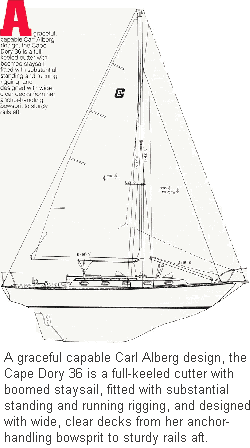 Spartan was born of this
need and now occupies a part of the East Taunton Factory where almost
all of the hardware, spars and rigging components for Cape Dory Yachts
are manufactured. Not only has this contributed to the quality of Cape
Dory's own yachts, but also directly to revenue since many Spartan
products, such as its well-designed bronze seacocks, are sold to other
manufacturers. This associated company now stands upon its own feet.
Spartan was born of this
need and now occupies a part of the East Taunton Factory where almost
all of the hardware, spars and rigging components for Cape Dory Yachts
are manufactured. Not only has this contributed to the quality of Cape
Dory's own yachts, but also directly to revenue since many Spartan
products, such as its well-designed bronze seacocks, are sold to other
manufacturers. This associated company now stands upon its own feet.
The Cape Dory Charter Company, moving into its third season, is another
smart move. Unlike most charter companies which practice a variety
of lease-back and similar tax-avoidance schemes to stock their fleets,
this one owns its own boats, assigned new to a small fleet operating
out of Marion, Massachusetts and, during the winter months, Clearwater,
Florida. This organization serves two excellent purposes: it is a fine
testing ground for the boats and, secondly, it enables a prospective
purchaser to spend a week in the yacht of his choice before making
a decision to purchase. If he buys, his charter fee is returned; if
he doesn't, at least he's had a sailing holiday. This seems to us a
neat way to sell a boat, and an even better way to buy one.
To return to our subject, the Cape Dory 36, it is obvious that the
faithful relationship with Carl Alberg that this company has maintained
over the years is in large measure responsible for the success of this
boat. In the world of cruising yachtsmen, no designer is more respected.
Carl Alberg is a man of the old school, yet his designs remain consistently
contemporary. Those that have been launched by good builders have become
sought-after classics. Alberg, resting on well-earned laurels in semi-retirement,
nevertheless still works closely with Cape Dory Yachts. The 36 is a
joint product of his design skill and the practical specifications
provided by Vavolotis and his team.
Finally, as engineer and chief of quality control at the factory,
whom do we find but OSTAR competitor Jim Kyle, class winner in the
Bermuda singlehander. Like all good sailors, he is a careful fellow,
and he greeted us with some suspicion. Not until we had exchanged a
variety of nautical experiences over lunch did he pay us a somewhat
backhanded compliment; he was "happy to find we weren't writers,
but seemed to know what we were talking about!"
Jim Kyle's quality control is far more than two words in his title;
there is an effective team, with each man an authority in his own field.
Together they operate with the aid of lengthy checklists, backed up
by in-house mechanical and chemical test facilities. While not wishing
to extol unduly the virtues of singlehanders (some people think they're
crazy), one must admit that their practical survival training when
coupled to engineering and design degrees imbues confidence in the
quality they control. Kyle is not a man to countenance poor practice
in the production of an ocean-cruising yacht.
And so to the construction of the 36.
The hull is laid up in a single mold mounted on a rotating frame
to permit easy access and near-horizontal surfaces for best resin
distribution. To make possible the construction of an integral inbound
lip for attachment of the deck/coachroof molding, a separate and
detachable flange section is bolted onto the mold. The lip is laid
up inside this section of the mold, which is then removed to permit
extraction of the completed hull.
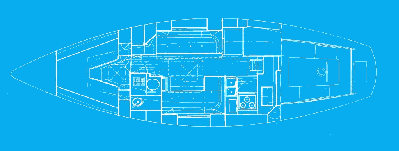 The layup is conventional alternate
layers of hand-laid mat and roving, tapering from a total of 15 layers
at the keel down to 10 at the topside flange. A chopper gun is, however,
used to set the first layer behind the gelcoat on the hulls and to
a greater extent in deck laminates; but to minimize the possibility
of gelcoat stress cracks at coachroof corners and cockpit coamings,
unidirectional glass strand is laid in as reinforcement.
The layup is conventional alternate
layers of hand-laid mat and roving, tapering from a total of 15 layers
at the keel down to 10 at the topside flange. A chopper gun is, however,
used to set the first layer behind the gelcoat on the hulls and to
a greater extent in deck laminates; but to minimize the possibility
of gelcoat stress cracks at coachroof corners and cockpit coamings,
unidirectional glass strand is laid in as reinforcement.
The molding shops are carefully controlled for both temperature
and air purity by powerful fan/filters; the bulk resin is stored
in tanks and piped from them to the working areas by means of a central
resin distribution system where it is subject to frequent chemical
check. We were particularly impressed by the care devoted to the
design and construction of the rudder. The 1 1/2" stainless
stock bar is curved inside the molding, following the shape of the
cutout for the propeller. The stock bar is solidly glassed into a
prepared trough. At the base of the rudder a cast bronze web with
gudgeon tube accepts the pintle pin on the heel casting which is
also glassed into the rudder molding. Next, the half shells are tilled
with reinforced polyester compound, glassed together and carefully
sealed with fiberglass tape.
One of Jim Kyle's phobias is the use of welding in a marine environment,
either for stainless steel or aluminum. He has a valid point, for
the molecular disturbance will create the possibility of small areas
of metal in way of the weldings becoming vulnerable to corrosion.
For this reason he has avoided the use of welding where possible
in the manufacture of hull hardware and spars. An exception is the
heavy steel bracket which holds the steering sheaves and stops. This
is not stainless, but mild steel, and is heavily paint-dipped for
protection.
Spartan spar construction shows similar attention to practical detail.
At the spreader attachment points, for instance, the compression
tubes do not pass through the mast where stress can be transferred
from one to the other. Instead, they are carefully placed inside
the mast extrusion, thus confining the load to the walls of the mast.
The gooseneck fitting is simple and strong, again not welded but
fitted and screwed into the boom. In the unlikely event of failure,
a spare can be easily substituted. This philosophy of practical simplicity
is evident throughout the construction and outfitting of this yacht.
Chainplate construction is again unusual, but has both logical and
sound engineering precedent. To remove as much steel as possible,
a change has been made here. In earlier hulls a steel web was used,
but after hull No. 71, now on the line, it is replaced by an aluminum
angle bar. Some three feet in length, this plate is glassed with
uni-directional strands into the hull under the lip. It is positioned
during the hull layup process, and the first layers of unidirectional
are led behind the last layers of roving, thus interlocking the whole
structure. Finally, the wide deck plates, well bedded, are bolted
through the deck/hull flange and aluminum bar.
This system eliminates any possible movement between chainplate
and deck, so often a source of leaks. Since the aluminum plate is
molded into the hull, which is also reinforced by the unidirectional
glass for a considerable distance down to its thicker cross-section,
the loads are evenly distributed and well spread.
Bulkheads and floors are well bonded, glasswork tidy and joinery
neat.
As we approached the end of the production line another unusual but
simple alternative solution to a major problem in fiberglass yacht
construction was found. The usual practice in developing a strong hull/deck
joint is to rely upon a heavy mastic for sealing while giving strength
by installing stainless-steel bolts at 4"-5" centers on a
lip of about 2". Cape Dory's system attempts to keep the mechanical
strength of bolts but also to eliminate leaks by reducing, insofar
as practical, the number of through-deck fastenings. Thus they extend
the lip to some 3 1/4" and use a semi-rigid polyester bonding
compound with considerable sheer strength. The joint is held tight
by fasteners during the bonding process. After curing, these are replaced
by 1/2" stainless bolts at 12" centers. The latter are then
covered by a well-bedded teak toerail whose screws pass through both
deck and hull flange for additional strength. A teak rubrail is then
screwed into the hull molding. It is significant that the thickness
of the hull laminate at the flange is some 3/8", substantial in
a vessel of this size.
Turning to electrical and engineering systems, we will comment on
what we were able to observe along the production line. A separate
lightning protection system consists of direct bonding of mast and
shrouds to an external grounding plate. Thus, the jolt of a lightning
strike is kept away from both electrical equipment and the through-hull
bonding system, which is an entirely separate web connecting all through-hulls
and tank groundings.
An integral 36-gallon fiberglass holding tank is glassed into the
hull molding above the ballast. The 43-gallon fiberglass fuel tank
and four molded polyethylene water tanks with a total capacity of 110
gallons are well secured in molded saddles. A 6-gallon hot water heater
installed in the port locker is standard equipment. Two heavy-duty
12-volt batteries, also carried in this locker, have properly color-coded
leads, and are well stowed in ventilated plastic containers and strapped
down, but readily accessible for servicing.
Electrical circuitry is efficiently installed, with 110- and 12-volt
breaker panels well set up. Polarity alarm, battery test and red circuit
indicator lights are all standard equipment.
There is hot water and a shower, but refrigeration must be an owner
option. The 110 circuits are supplied for water heater and outlets
only, but three additional plugs are available on the breaker panel
for battery charger or other options. On the 12-volt panel a breaker
is provided for the radio and for the instruments; again, two spares
are available for extra circuitry such as stereo or Loran systems.
The installation of the Perkins 4-108 diesel allows ease of maintenance,
the compartment is nicely soundproofed, and a drip tray is provided.
Two filters on the fuel line, one a water separator, are standard.
Engine bearers are steel-cored fiberglass strongly bonded to the hull
with the load well spread. Noteworthy is the prop-log stuffing box,
a "Spartan special" designed so that it can be adjusted with
the tap of a hammer instead of the usual battle of finding a wrench
to fit-cunning!
The interior is light, bright and airy. Perhaps the most outstanding
feature is the warmth and luxury of the polished bronze portlights
and hardware supplied by Spartan. These are a Cape Dory trademark,
but they are not just decorative; the portlights are very tough hardware
and carry heavy safety glass which has plenty of strength and will
not craze with age.
In the old pre-war Navy days, it was said that one of the reasons
there was so much brass around was that it gave the crew something
to do when they were not fighting. Maybe polishing all these beautiful
fittings will keep the crew from fighting. Providing, of course, that
they take turns!
In the standard V-berth (with filler) forecabin there is 4" foam
upholstery, ample headroom and satisfactory dressing space. The head
is a glass molding easy to keep clean and very adequate in space and
arrangement. The basin, shower and ice box drain into a bilge sump.
This we don't much like, since emptying the bathwater into the basement
is not good housekeeping. Bilge sumps are difficult to clean and get
very "ucky" with old soap, - spilt milk, etc. A shower sump
with automatic overboard discharge and a small hand pump for removal
of icebox sediment into a sink-drain connection would be preferable.
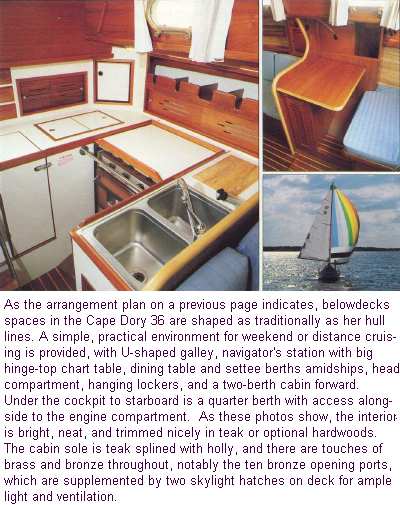 The galley is good news, with plenty
of working, drawer and stowage space. Jean again complained that she
found no allowance for her toes under the counters. Like gimballed
tables, these spaces under galley furniture, which make standing at
work so much more comfortable, seem to be rare. We also felt that in
a 36' cruising vessel an alternative refrigeration system might be
taken into account, and that the 2 1/2" insulation of the box
is marginal. In tropical conditions, nothing under 3" is really
effective. The gimballed 3-burner stove with oven is available with
either alcohol or gas fuel to ABYC-approved systems.
The galley is good news, with plenty
of working, drawer and stowage space. Jean again complained that she
found no allowance for her toes under the counters. Like gimballed
tables, these spaces under galley furniture, which make standing at
work so much more comfortable, seem to be rare. We also felt that in
a 36' cruising vessel an alternative refrigeration system might be
taken into account, and that the 2 1/2" insulation of the box
is marginal. In tropical conditions, nothing under 3" is really
effective. The gimballed 3-burner stove with oven is available with
either alcohol or gas fuel to ABYC-approved systems.
Despite these quibbles, our enthusiasm for the general standard of
the interior remains: 6'4" headroom in the saloon with grabrails
both sides, in addition to drip rails under the ports. Comfortable
settees with sloped backs. Solid drop table with shelves behind on
the bulkhead. (A pedestal table is an available option.)
One touch much appreciated by old cruising hands is the thought applied
to the Cape Dory 36 "Owner's Manual." This includes a commissioning
check list, simple instructions on all systems, including pipe and
wiring diagrams, and even a list of addresses for all subcontractors
together with part numbers-everything from sheet blocks to light bulbs.
And so on deck for the sea trial. An inspection of this boat's rigging
inspires confidence-with standing rigging 1 x 19 Seabrite stainless
to open Merriman turnbuckles and toggles, and halyards all rope in
the form of pre-stretched Marlow braid. Spreaders are very wide and
shroud leads well out to give both good mast support and clear space
for movement fore and aft on deck. Double-rail stainless pulpit and
stemrail, double guardrails, small cockpit well with ample seats, and
half deck with good sill height to companionway-all contribute to a
feeling of security in ocean sailing and the assurance of comfort and
deck space for weekend cruising.
The boomed staysail and mainsheets clear of the cockpit, with provision
for double jiffy reefing, seven Lewmar winches with two-speed #40 self-tailing
Lewmar primaries, and light and sensitive wheel, made control and sail
handling a pleasure. Under both power and sail the yacht maneuvered
like a dinghy, turning in both directions almost in her own length.
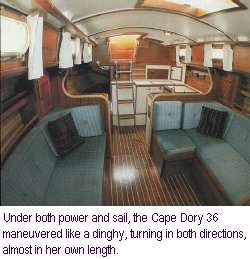 Under power,
the Cape Dory 36 exceeds seven knots at cruising rpm and moves without
fuss. Noise level is low in the cockpit and below. Under sail, with
wind speeds between fifteen and eighteen knots, we carried 100% genoa,
staysail and full main. The boat is stiff, but control was finger light
on all headings. There was no compass on board so that accurate tack
angles could not be obtained, but she drove well to windward with staysail
slightly eased to provide a good slot. Under main and staysail only,
tacking without sheet handling was quick and acceleration was good.
We did not encounter rough water this trip, but in the slight chop
there was little movement.
Under power,
the Cape Dory 36 exceeds seven knots at cruising rpm and moves without
fuss. Noise level is low in the cockpit and below. Under sail, with
wind speeds between fifteen and eighteen knots, we carried 100% genoa,
staysail and full main. The boat is stiff, but control was finger light
on all headings. There was no compass on board so that accurate tack
angles could not be obtained, but she drove well to windward with staysail
slightly eased to provide a good slot. Under main and staysail only,
tacking without sheet handling was quick and acceleration was good.
We did not encounter rough water this trip, but in the slight chop
there was little movement.
During the sailing trial we were accompanied by the new owners, who
had just completed sailing school. This was their first "big" boat
and their first time out in her. After some initial apprehension they
began to share our confidence. When we departed we were convinced that
they had chosen well; they would have little difficulty mastering this
wholesome thoroughbred and were destined to enjoy some very rewarding
sailing.
Altogether, we found the Cape Dory 36 an excellent vessel for the
cruising sailor - comfortable, simple, seamanlike. She should be equally
at home on a social weekend or an ocean crossing.
Specifications:
| LOA: |
36' 1 1/2" |
| LWL: |
27' |
| Beam: |
10' 8" |
| Draft: |
5' |
| Sail Area: |
622 sq. ft. |
| Ballast: |
6050 pounds |
| Displacement: |
16,100 pounds |
| Fuel: |
42 gallons |
| Water: |
130 gallons |
| Power: |
Perkins 50-HP 4-108 diesel |
| Spars: |
Aluminum finished with Awlgrip |
| Designer: |
Carl Alberg |
| Builder: |
Cape Dory Yachts,
160 Middleboro Avenue,
East Taunton, MA 02718 |
Page last updated February 7, 2000.
Article and illustrations scanned and clearance
obtained by Ken Coit.,
who says:
"We have a number of people to thank for gaining
the right to publish the article on the web site:
Fraser and Jean Fraser-Harris, of Bristol, UK,
the authors.
Joseph P. Gribbins, the Editor of Nautical Quarterly
at that time and now with Mystic Seaport did a bit of research
on the article for us.
Dave Perry, formerly the Sales Manager for Cape
Dory and now with Robinhood Marine, who identified Windsong, the
individuals in the photos, the fact that the photos were from a
Cape Dory brochure, and that Windsong was in the fleet of Cape
Dory Charters.
Dave Perry tells us that the crew on the photo
shoot were all Cape Dory employees and had signed releases: Lou
Scott, Purchasing Manager at CDY is at the helm, Ed Reily, Quality
Control inspector, on port side and Hunter Scott, Assistant Production
Manager, is starboard.
Esther Pope, Editorial Assistant at Soundings,
helped get the ball rolling with an address for Fraser and Jean
Fraser-Harris in the UK and the lead to Joe Gribbins at Mystic
Seaport.
And, there were others who responded to my direct
inquiries or broadcasts for assistance with clues about Windsong."





